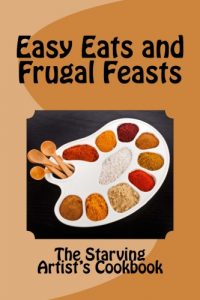WILL WRITE FOR FOOD
By Christina Hamlett
 Over the course of 25 years, friends who broke bread at our dining room table never failed to suggest that the two of us should turn our culinary capers into a cookbook. In 2017, I took them up on the challenge and published Easy Eats and Frugal Feasts—a collection of fun recipes, stories and photos from my days as a struggling young actress.
Over the course of 25 years, friends who broke bread at our dining room table never failed to suggest that the two of us should turn our culinary capers into a cookbook. In 2017, I took them up on the challenge and published Easy Eats and Frugal Feasts—a collection of fun recipes, stories and photos from my days as a struggling young actress.
It was Mark, though, I always deemed the more savvy chef and, thus, began my quest to encourage his own wordsmithing on the subject. This was a man who not only embraced cuisine from every country in the world but who could also whip up a gourmet meal just from one glance in the pantry and fridge. He was, however, notorious for not writing anything down—clearly an obstacle if anyone wanted to replicate his wizardry!
 I felt a sense of accomplishment when he finally started drafting an outline for what he would title The Open Door Gourmet. Now and again he’d share what he had written but I knew better than to pester him by asking, “Is it done yet?” In what turned out to be the last year of my beloved’s life, I had no idea how much progress he had actually made, much less where he kept the file.
I felt a sense of accomplishment when he finally started drafting an outline for what he would title The Open Door Gourmet. Now and again he’d share what he had written but I knew better than to pester him by asking, “Is it done yet?” In what turned out to be the last year of my beloved’s life, I had no idea how much progress he had actually made, much less where he kept the file.
It was only by a stroke of luck a few months ago I discovered a flash-drive I had overlooked. On it were half his recipes, the table of contents, resource lists for spices and herbs and even the cover I had designed for him. What better sign did I need than to add this to my list of current projects and commit to getting it published on his behalf by this Christmas.
The more people I’ve told about it, the more have shared their own stories about family recipes, coupled with befuddlement about how, exactly, to turn them into a cookbook. If you, too, fall into this category, here are the four things you need to know to get started.
THEME
Cookbooks come in as many sizes and varieties as cooks themselves. For example:
Celebrity – in which well known chefs (or restaurants) divulge their culinary best
Regional – the foods of a particular geographical area
Ethnic – the menus of a particular country or its people
Historic – tastes and tales of another era
Budget Conscious – the title says it all!
Dietary Restrictions – meals that address specific health conditions
One Food Wonders – books that relate 200 things you can do with a radish
One Course Specials– i.e., soups only, or hors d’oeuvres galore.
Whether you plan to self-publish or pitch an agent, it’s important to have a unifying theme beyond just the food itself. “Cooking With Ethel” may look charming on a book jacket, but who exactly is Ethel? And why would anyone want to learn her kitchen secrets? The reason is that Ethel—or you—added a creative slant to otherwise generic material by offering something more than just another book about entertaining and food preparation. Let’s say, for instance, Ethel’s recipes have been handed down through the generations and date from the Revolutionary War.
Or maybe Ethel herself was blind since birth and learned everything about cooking through scent and texture. The subliminal hook of the first example is that these are not only “timeless” recipes but may contain sidebar snippets of everyday life in the 1700s. The enticement of the second example mixes inspiration with simplicity; if a person who can’t see what she’s doing can create such fabulous desserts, so can anyone else! A trip to your local bookstore or through the pages of a mail order catalogue will yield an overview of how heavily the above markets are saturated…or screaming for fresh-picked topics.
AUDIENCE
Who are your target readers? Before you type up your first menu plan, you need to know who you’re writing for. Are these seasoned chefs who not only understand all the lingo of the kitchen but also possess an enviable arsenal of expensive gadgetry? Or are they beginners who wouldn’t know a truffle from a trifle and whose cupboard consists of one frying pan and some wooden spoons?
Likewise, are the people who buy your book those who have the luxury of an entire afternoon to cut up ingredients or are they harried parents who have less than an hour after work to get a nutritious meal on the table for a family of four? An additional factor to consider with your target audience is accessibility of the ingredients. Many Middle and Far Eastern recipes, for example, call for fresh herbs and spices as opposed to a powdered variety. Have you accounted for this requirement? If not, you could easily lose a sale for the simple reason that people casually thumbing through your book realize they couldn’t possibly acquire all the components at the neighborhood Safeway.
LAYOUT
Along with assessing the skill level of your cookbook’s potential users is the need to display the material in a format that’s easy to follow as well as attractive to the eye. Most cookbooks are laid out in the same sequence as actual courses, starting with appetizers and ending with desserts. Regional cookbooks might take a different approach, segregating the material by North, South, Central, etc. Yet another method is to increase the complexity of each dish as the reader becomes more accomplished.
What about the menus themselves? The two most important rules are: (1) Don’t leave anything out, and (2) Provide accurate measurements. Granted, most cooks will become bold and experimental after their first try, substituting various ingredients and forsaking measuring devices completely. Accordingly, those innocuous and subjective terms like “a smidge” and “a tad” will have a meaning to them which is separate and apart from the more precise directions you have initially provided in print.
How will they know if they’ve done it right? Not only are color photographs an effective guideline to presentation but the right one on your front cover can entice a buyer right from the get-go. Last but not least is the icing which makes your book distinct—the inclusion of sidebar anecdotes, historical references, menu substitutions, or “food first-aid.”
MARKETING
Just as with any book, you need to get the word out when it’s published. Consider some of these in your marketing strategy:
- Demonstrations at local cooking schools.
- Stand alone articles, interviews, and recipes in food and wine publications.
- Giveaway recipe cards.
- Radio interviews.
- Networking through local caterers.
- Fund-raising events for charities. Not only are you writing the sales off as donations but it’s also getting your book into the public’s oven mitts!
—
Former actress and theatre director Christina Hamlett is an award-winning author whose credits to date include 50 books, 273 stage plays and squillions of articles and interviews. Along with her UK cozy mystery series (available on Amazon), she is a script consultant for stage and screen. Learn more at www.authorhamlett.com.
THE OPEN DOOR GOURMET
 This cookbook is absolutely not for people who rise early to visit the French market off Boulevard St. Germain, pick out the plumpest chicken, take it home, kill it and strip off all the feathers. It’s for workaday people who come home after a long day at the office or are staring down a holiday weekend with guests coming and having nary an idea what to bring to the table which can impress without stress.
This cookbook is absolutely not for people who rise early to visit the French market off Boulevard St. Germain, pick out the plumpest chicken, take it home, kill it and strip off all the feathers. It’s for workaday people who come home after a long day at the office or are staring down a holiday weekend with guests coming and having nary an idea what to bring to the table which can impress without stress.
My simple premise is that if you have a well provisioned pantry, an appetite for adventure and a passion for making even the most pedestrian meal an occasion to celebrate and remember, you can put together something satisfying and tasty from any country in the world. The recipes are gleaned from 25+ years of cooking for ourselves and friends and guaranteed to make anyone who tastes them want to lick their plates and ask for second helpings. At the end of the day, does a home chef really need any more encouragement than that?
BUY HERE
Category: How To and Tips

























